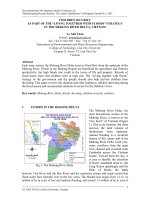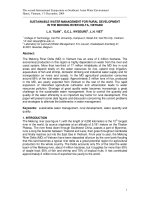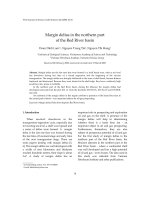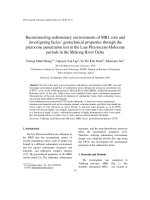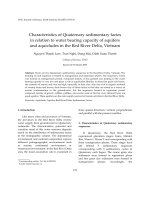Children security as part of the " living together with floods" strategy in the Mekong river delta, VietNam
Bạn đang xem bản rút gọn của tài liệu. Xem và tải ngay bản đầy đủ của tài liệu tại đây (375 KB, 8 trang )
The International Development Studies Conference on
"Mainstreaming Human Security: The Asian Contributiuon" in Bangkok, October 4-5, 2007
---------------------------------------------------------------------------------------------------------------------------------
----------------------------------------------------------------------------------------------------------------------------
LE ANH TUAN, CanTho University, Vietnam
1
CHILDREN SECURITY
AS PART OF THE “LIVING TOGETHER WITH FLOODS” STRATEGY
IN THE MEKONG RIVER DELTA, VIETNAM
Le Anh Tuan
E-mail:
Tel: +84.71.834 539 Fax: +84.71. 831 151
Department of Environmental and Water Resources Engineering,
College of Technology, Can Tho University
Campus II, Street 3/2, Can Tho City
Vietnam
Abstract
Each rainy season, the Mekong River Delta receives flood flow from the upstream of the
Mekong River. Floods in the Mekong Region are beneficial for agriculture and fisheries
productivity, but high floods also result in the losses of life and property. Records of
flood losses show that children were at high risk. The “Living together with floods”
strategy of the government and the people should also help prevent children from
drowning. This paper reviews the situation and risks leading to children drowning during
the flood season and recommends solutions to secure for the children’s lives.
Key words: Mekong River Delta, floods, downing, children security, solution.
1. FLOODS IN THE MEKONG DELTA
The Mekong River Delta, the
most downstream section of the
Mekong River, is known as the
"rice bowl" of Vietnam (Figure
1). Due to its location, the delta
receives the total volume of
floodwaters from upstream.
Annual flooding is a recurrent
feature of life, nature and in the
Mekong River Delta. Each year,
water overflows from the main
river channel and overland from
Cambodia across the Vietnam
border. Viewed from the sky, it
is easy to identify the extension
of flood inundated areas in the
Long Xuyen quadrangle and the
Plain of Reeds, the lands
between Tien River and the Hau River and the numerous stream and canal system that
flood water flow laterally over to the low areas. T
he flooded area ranges from 1.2 to 1.4
million of ha in years of low and medium flooding, and around 1.9 million of ha in year of
Fig.1: The Mekong River Delta
The International Development Studies Conference on
"Mainstreaming Human Security: The Asian Contributiuon" in Bangkok, October 4-5, 2007
---------------------------------------------------------------------------------------------------------------------------------
----------------------------------------------------------------------------------------------------------------------------
LE ANH TUAN, CanTho University, Vietnam
2
Fig. 2: Flood area in Cambodia and the
Mekong Delta (Yamashita, 2005)
high flooding (
Socialist Republic of Vietnam
[SRV], 2005).
Flood waters start in July,
increase gradually in August-September, and peak in October before falling in November
(Figures 2).
Based on the peak water level at Tan
Chau Gauging Station of An Giang
province, hydrologists consider that a low
flood occurs when the flood peak in Tan
Chau is less than 4.0 m, moderate floods
occur when the flood peak is between 4.0
and 4.5 m, and high floods occur when
the flood peak is more than 4.5 m. High
floods are caused when three
simultaneous factors happen: large water
discharges originating from upstream as a
result of typhoons or tropical low
pressures; long and heavy rainfall in the
MD itself; and high tides that lead high
water levels in the rivers and canals
system preventing easy drainage (Tuan,
Guido, Viet & Haest, 2004). Given the water level of more than 4.20 m at Tan Chau, the
MD has exceeded emergency flood conditions 22 times since 1926 - 2006 (Figure 3).
Peak Water Levels in TanChau (1926 - 2005)
0
100
200
300
400
500
600
19
2
6
192
8
193
0
193
2
19
3
4
19
3
6
19
3
8
194
0
194
2
194
4
19
4
6
19
4
8
19
5
0
195
2
195
4
195
6
19
5
8
19
6
0
19
6
2
196
4
196
6
196
8
197
0
19
7
2
19
7
4
19
7
6
197
8
198
0
198
2
19
8
4
19
8
6
19
8
8
199
0
199
2
199
4
19
9
6
19
9
8
20
0
0
200
2
200
4
Year
Peaks (cm)
Fig. 3: Peak levels in Tan Chau in 1926 - 2005
In 2000, the Mekong River Delta faced a historically high flood, as severe as that of 1961
which was the most destructive flood in past 70 years. The flood in 2000 was extreme not
only in terms of its very high peak level and discharge but also the earlier than usual
arrival of the flood by approximately 4 – 6 weeks (Mekong River Commission [MRC],
2005). In particular, the flood event in 2000 had two peaks, the first one in August 3rd
with the water level reaching over 4.0 m, then one month and 21 days later it was
followed by a second peak of 5.06 m in September 24th, very close to the highest peak
observed in 1961. The high peak of the water level in 2000 was 19 cm higher and 12 days
earlier than the flood recorded in 1996 (Figure 4). The flood in 2000 had a volume of 420
million m
3
, distributed between the main stream flow and runoff volumes from Cambodia
The International Development Studies Conference on
"Mainstreaming Human Security: The Asian Contributiuon" in Bangkok, October 4-5, 2007
---------------------------------------------------------------------------------------------------------------------------------
----------------------------------------------------------------------------------------------------------------------------
LE ANH TUAN, CanTho University, Vietnam
3
as 17% to Hau River, 65% to Tien River, 3% to Long Xuyen Quadrangle and 15% to the
Plain of Reeds. Flood water levels in the Plain of Reeds area, and in the Long Xuyen
Quadrangle area were 30-50 centimetres higher than the ones recorded in 1961, 1978,
and 1996 (SRV, 2005). Due to the Delta is very flat and low, the higher level in the flood
results a higher damage in social and economic.
0
100
200
300
400
500
600
24-May 13-Jul 01-Sep 21-Oct 10-Dec 29-Jan
Date
Water level (cm)
2000 1996
Fig. 4: Water level in the floods in 1996 and 2000 at Tan Chau Station
2. CHILDREN IN THE FLOOD SEASONS
The Delta’s total population is estimated approximately 18 million people (2006), half of
them are children. Apart from for those living in the urban areas, children in the rural area
are familiar with the water in rivers and canals. Their daily lives are linked with the rice
fields and flood plains. Some of them learn to swim at early age, but others were not
trained. There is no official swimming training in the school program in the Mekong
River Delta. It seems an irrational structure for children living in a floodplain as the
Delta.
In the flood seasons, many schools and houses are often inundated. As a result, children
left unattended in simple houses in stilts or boats are at risk while their parents were out
looking for food, fish, vegetables or working. Most of drowned children come from the
poorer communities although they habituate with the water around. Local people said that
almost the deaths of young children occurred at night when they rowed and fell down the
water while sleeping.
In Vietnam, the first day of the new academic year is usually in early of September. In
the MD, this period coincides with a high risk of flood. Many pupils and students go to
schools in the narrow wooden boats without life-vests or lifebuoys. Boat overturn
accidents may cause many deaths of children from drowning. In peak flow periods, all
children (over 160,000) in the high inundated areas are not attending their schools.
The beginning and the end of the rainy season are the best time for mosquito
reproduction resulting in mosquito-based diseases. A recurrent dengue epidemic hits
The International Development Studies Conference on
"Mainstreaming Human Security: The Asian Contributiuon" in Bangkok, October 4-5, 2007
---------------------------------------------------------------------------------------------------------------------------------
----------------------------------------------------------------------------------------------------------------------------
LE ANH TUAN, CanTho University, Vietnam
4
children in rural areas, big cities and towns. Incidence of dengue fever was commonly
thought to rise in the flood season (Few, Tran & Hong, 2004). Many provincial health
services offices in the Delta reported dengue fever outbreaks. In 2007, the Delta’s health
centres were overloaded with children infected by dengue fever. Vietnam’s worst dengue
epidemic in recent times occurred in 1998 when 300,000 cases and 480 deaths were
reported (Thanh Nien Newspaper, 2007). In 2000, 81.6% (40/49) of the deaths due to
Dengue fever were reported from 9/12 provinces in the Mekong delta region. In 1999-
2000, those mainly affected were below 15 years of age (92.7%) (89/96 deaths) (Tien,
Tuan, Tuan, Toan & Quang, 2001).
Apart from drowning and dengue the other lading cause of deaths was snake bites. In the
flood seasons, water occupies the surface land. Snakes find shelter from floods in higher
positions such as trees and houses.
Table 1 gives some statistical data showing high percentage of child deaths in the total
the losses of life in the flood seasons in the MD. Save the Children (2003) reported that
the vast majority of the drowning deaths in recent years in the region was mainly
children, mostly aged under six years of age. The number of the deaths since 2000 started
to decline thanks to the building of residential clusters for people and day-care centres for
young children during the floods.
Table 1: Losses of human life in some flood seasons in the MD
Year 1994 1995 1996 1997 2000 2002 2004 2005
Total deaths 407 199 250 607 280 132 35 77
No. of children deaths 265 180 160 524 211 114 30 65
% of children deaths 65.11 90.45 64.00 86.32 75.35 86.36 85.71 84.41
(Sources: Data collected from the reports of SRV(2005) , Chung (2005), international
organization MRC(2005), ADRC (2005), UNICEF (2000) and author’s documentations)
3. LIVING WITH FLOODS
High floods in the Mekong Delta caused significant loss of life and destruction. The
damage costs depend on flood levels in each year. The higher economic development in
the recent years results in higher costs of damage. Floods in the Mekong Delta are not
perceived as disasters by many farmers and scientists. Floods have positive effects and
ecological functions. Positive effects of flood include sedimentation, fisheries, other
flood products, leaching toxic in acid sulphate soils, eliminating rats and insects,
provision of fresh water, refilling of groundwater, and protection of forest and provision
of ecosystem services.
The 2
nd
Vietnam National Strategy and Action Plan for water - related disaster mitigation
and management in the period 2001 - 2020 adopts a key strategy of preparedness and
mitigation to the Mekong floods, while harnessing their environmental benefits, as
“Living Together with Floods”. This motto is understood as an integrated solution for
adaptation and protection of human life and property, to maintain safe and sustainable
The International Development Studies Conference on
"Mainstreaming Human Security: The Asian Contributiuon" in Bangkok, October 4-5, 2007
---------------------------------------------------------------------------------------------------------------------------------
----------------------------------------------------------------------------------------------------------------------------
LE ANH TUAN, CanTho University, Vietnam
5
housing for local people, and to maintain social security (Truong, 2006). This National
Strategy implies the children security specifically in general meanings.
Floods can be controlled by both structural and non-structural measures depending on the
natural and social-economic conditions. Figure 5 provides some available ways for flood
mitigation in the Mekong River Delta.
Fig. 5: Some ways for “Living Together with Floods” in the MD
4. CHILD SAFETY
In heavily and medium inundated areas in the Mekong River Delta, provincial
government offices and non-government organization have been providing assistance to
build residential clusters for the villagers. Children in flooded areas should be moved to
and kept in these residential clusters. The main goals are to protect children from life-
threatening situations and to ensure access to education for children during the flood
seasons. Below are some activities for children safety that have been done or suggested.
4.1. Adjusting School calendars
As a traditional event, all schools in Vietnam start the new academic year on the same
day, usually on the fifth of September. However, if merging the school semesters
calendar with the Mekong river flow rate diagram, we may easily see that the school
opening day coincides with the high flood period. In recent academic years, the Ministry
of Education and Training allows local educational authorities to choose and adjust their
school calendars reflecting the real natural conditions. Figure 6 proposes a school
Living Together with Floods
Structural measures
Non-Structural measures
Building flood
protection dykes
Widening/deepening
drainage channels
Raising evacuation of
public infrastructure and
housing foundations
Upgrading the hydro-meteorological
monitoring network and data processing
Providing mass public
communication and
awareness education
Diversifying the crop
production calendars
Finding the solution for
children security
